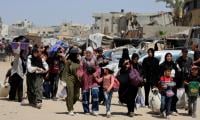ROME: Half a million people live on a sprawling volcano in Italy -- and the risk of an eruption has never been greater, according to a study published Friday. The Campi Flegrei (Phlegraean Fields) volcano may be less well-known than Vesuvius, but is “extremely dangerous”, study co-author Stefano Carlino told AFP. Vesuvius wiped Pompeii off the map almost two millennia ago, while the vast volcanic Campi Flegrei area near Naples last spewed lava, ashes and rocks in 1538. But the Campi Flegrei is not one to take lightly -- the volcano´s eruption 30,000 years ago is reported to have contributed to the extinction of Neanderthal man. One could be forgiven for not realising its danger though, because instead of growing into a traditional mountain, the volcano has the shape of a gentle depression 12-14 kilometres (7.5-8.5 miles) across.A resurgence of activity in the early 1980s led to the evacuation of 40,000 inhabitants, but the volcano has been relatively quiet since then. “We´re not saying there will be an eruption, we are saying that the conditions for a eruption are more favourable,” Christopher Kilburn from University College London told AFP. The tens of thousands of small earthquakes that have taken place since the 1950s weakened the caldera, the basin at the top of the volcano.
And the report -- published in Nature´s Communications Earth & Environment journal -- found “parts of the volcano had been stretched nearly to breaking point”. The quakes have been increasing in number since 2019, while the pressure below has been building. The coastal town of Pozzuoli has been lifted by nearly four metres (13 feet) -- roughly the height of a double-decker bus -- since the 1950s, it said. The tremors and ground uplift are cumulative, meaning volcanic activity does not need to intensify for an eruption to become more likely. “An eventual eruption could be preceded by relatively weak signals, such as a smaller rate of ground uplift and fewer earthquakes,” the study´s authors said in a press release. They point to the eruption of the Rabaul caldera in Papua New Guinea 1994, which was preceded by small earthquakes occurring at a tenth of the rate than had occurred during a crisis a decade before.
The boost for Harris came amid new turmoil for 78-year-old Trump, who cast into doubt whether he will debate the vice...
“It was, unfortunately, a bullet that hit my ear, and hit it hard. There was no glass, there was no shrapnel,”...
Starting this month, three autonomous on-demand delivery robots will begin their trial within the community
“They identify where our mobile groups are positioned, where the machine guns are that can destroy them," says...
Biden describes the pair as “two of the most notorious leaders of the Sinaloa Cartel”
Wang says Beijing is “ready to work with Russia to... firmly support each other, safeguard each other’s core...







